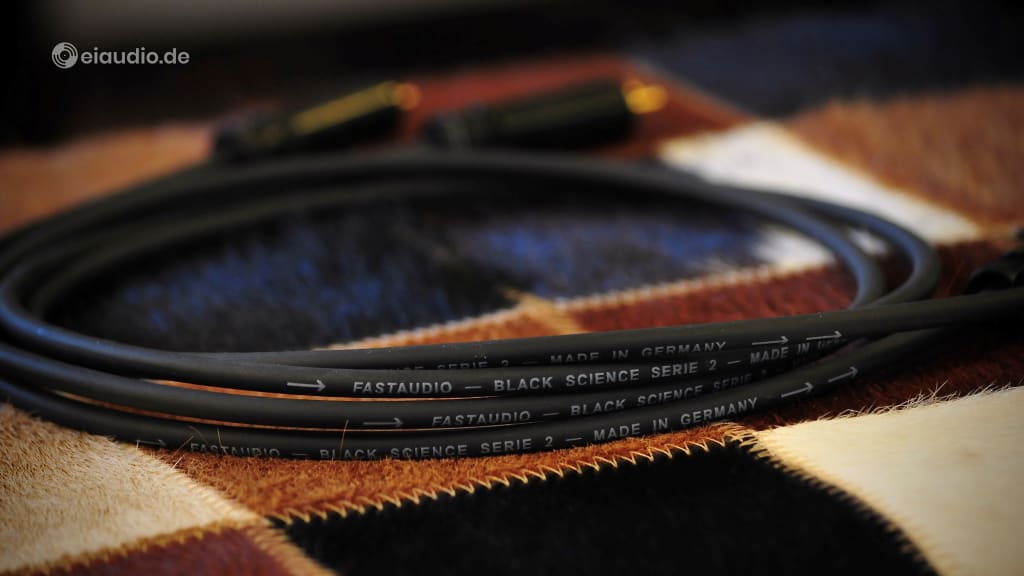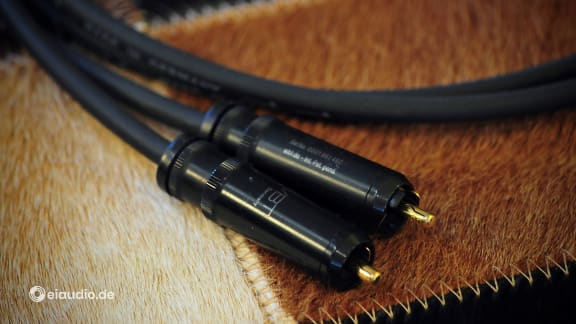fastaudio Black Science MK II
Published: 14/12/2020
Manufacturing date: 2020
Author: Karsten Hein
Category: Gear & Review
Tag(s): Cables
Thomas Fast opened his first HiFi studio in Stuttgart in 1998 and has since become a trusted focal point for audiophile music enthusiasts nationwide. Fastaudio offers a range of quality services, ranging from the sale of HiFi and High End components to the setting up and fine-tuning of these components in households, offices, or in professional studios. Today, fastaudio is also a reputable manufacturer of cables and acoustic room treatment solutions.
The fastaudio Black Science MK II RCA/cinch interconnect is a cable of the brand’s own making and—now in its fourth generation—has made a name for itself as an able performer. It can be purchased in many different lengths, and terminated versions offer a choice of plugs: the more affordable Neutrik NF2 CB-2, and the pricier WBT Nextgen. Both Neutrik and WBT undoubtedly make excellent plugs. I have been a fan of the NF2 CB-2s, mainly because of their massive feel and their convenient spring mechanism, a design by which the ground is pushed into the outer shell when plugging it in, thus creating an easy to place, but very firm, grip on the socket. It really is an incredibly well-designed plug.
The version of the fastaudio Black Science MK II that is shown here has been terminated with WBT’s Nextgen plugs. Just from looking at the design of the interconnect, it becomes clear that fastaudio means serious business. There is the hollow center prong of the WBT that is split apart ever so slightly as to provide maximum contact with the socket. Instead of a circular outer contact, the WBT grips the outer part of the socket in a controlled manner. The cable itself has been designed to reduce skin-effects by using a blind mesh. Both its shield and hollow inner conductor run parallel to its longitudinal axis to reach a more favourable ratio of inductance and capacitance. A promising design in many ways.
The name Black Science itself is an allusion to ‘black’ magic (or voodoo, as cable critics would have it), to the concept of the cable as an inexplicable ‘black’ box, as well as to ‘science’ and research, disciplines that help to shed light on the many undiscovered mysteries in the universe. I cannot be certain that this was Thomas’ intention when naming the cable, but, as linguist, I cannot help but place the name in the context of popular discourse.
Advert eiaudio/shop:
With its shielded design, the Black Science MK II will most likely be connected between preamplifier and amplifier. (Fast makes a separate version for connecting to phono, that either comes terminated with the traditional 5-pin DIN or simply as RCA/cinch and includes a separate ground lead terminated with spade.) The cable that I had been using instead of the fastaudio until this point was the EPIC 1 of Haegermann audiolabs. I had chosen this cable, because it was fast, accurate, and forward sounding with great dynamics. In this setup, our system could appear a little harsh at times. In combination with the electrostatic speakers it seemed to deliver enough detail. I did not miss much in the music but was not terribly excited about the sound either.
Upon connecting the Black Science MK II between preamp and amp, I first noticed that the stage had difficulty forming, the sound was a bit muddled, and I sensed a slight 50Hz humming on the right channel while the left channel was dead silent, as is usual for the DB1-ST140 combo. I checked the position of the cables and made sure that they neither crossed nor touched. I checked the sound again and seeing some improvement, I doubled my efforts of placing the cables, until both channels were silent. Standing next to the system and the bi-directional electrostatic speakers, it is difficult judge the impact of any change, except for obvious flaws such as humming. But sitting back on the couch, I immediately noticed that my efforts were starting to pay off.
When properly placed and connected, the Black Science MK II is capable of constructing a very convincing stage with plenty of natural width and depth. It does this much better than the EPIC 1 with which the music was more entangled with the speakers. The MK II plays more seamlessly when panning left to right and also reaches out further into the far left and right corners of the room. The cable seemingly provides a greater spectrum of sound and is able to show more nuance. Individual notes linger much longer. This is especially obvious when listening to natural instruments being played. Jamie Saft's 'Loneliness Road' really shines in all its natural beauty, providing fully contoured natural bass. Instruments and voices are presented without tonal coloration. Comparing our two present HiFi systems, the Restek-Hafler-Tannoy and the DB1-ST140-MartinLogan, I can say that the latter paints in slightly warmer and therefore more pleasant colours whilst offering similar dynamics and detail. If this can at least partly be attributed to the fastaudio cable, I would tend to see this as an asset and still be perfectly happy with its performance.
Tested on the following setup: CD player: Marantz CD-17 (on WesternElectric); Preamp: DB Systems DB1 (on fastaudio Black Science MK II); Power amp: B&K ST-140; MartinLogan SL3 (bi-wired, on Belden 9497)
Specifications
- Cable lengths: 100cm
- Longitudinal resistance: 100 Milliohm/m
- Parallel capacity: 53 Pikofarad/m
- Serial Inductance: 0,3 Microhenry/m
- Characteristic impedance: 60 Ohm
- Handling: directional, soft flexible
- Termination: WBT Nextgen
- Position tested: pre to amp
- Country of manufacture: N.N.
- Year(s): 2020





